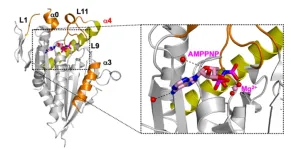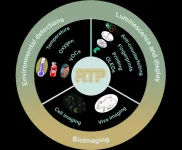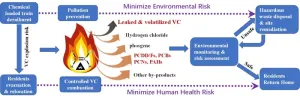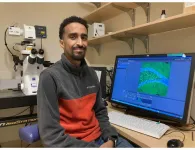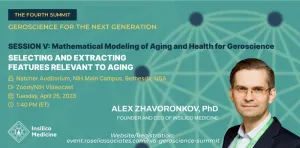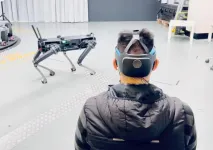(Press-News.org) Professors Stefan Seelecke and Paul Motzki at Saarland University are developing intelligent materials that are opening up new avenues in sound reproduction technology: lightweight loudspeakers that use far less energy than their conventional counterparts, novel shapes for sound and signal generators and applications involving noise cancelling textiles. The basis for these smart materials are ultrathin silicone films that can act as artificial muscles with their own built-in sensors. The research team will be showcasing their new technology at this year’s Hannover Messe from 17 to 21 April (Hall 2, Stand B34).
Ultrathin films may well replace the heavy and power-thirsty components found in today's loudspeakers – making speaker systems lighter and environmentally more sustainable. And that wouldn't just make life easier for the stage technicians and roadies who have to stack speaker towers in stadiums and concert halls, it could also reduce electricity demand in millions of homes. The magnetic speaker drivers that are typically found in public-address systems and stage speaker setups use a lot of electric power. It's not unusual for power levels to reach hundreds of thousands of watts at large-scale events. But power consumption in domestic surround-sound installations (home music or home cinema systems) is also not inconsiderable. Most of us know how quickly a battery-powered (wireless) speaker needs recharging.
But the new technology being developed by Professor Stefan Seelecke and his research team at the Intelligent Material Systems Lab at Saarland University and at ZeMA (Center for Mechatronics and Automation Technology) in Saarbrücken is markedly more energy-efficient. Their technology does not rely on expensive and difficult-to-source materials; all it needs is a silicone film, some carbon black and a smart control unit. These new film-based drive systems offer the possibility of creating loudspeakers with totally new shapes. 'Our smart material systems made from dielectric elastomers are opening up opportunities to rethink much of what we know in the field of acoustics. These systems could help to make loudspeaker technology more sustainable and to develop it in new directions,' said Professor Stefan Seelecke.
The range of possible applications is very broad. For example, the films could be integrated into wall-mounted textiles to actively cancel ambient noise, or if worn on the body, they could emit acoustic signals. The research team from Saarbrücken are showcasing their technology at this year's Hannover Messe, where they will be looking for commercial and industrial partners with whom they can research and develop the technology for new applications.
The technology is based on thin silicone films coated with an electrically conducting layer to create dielectric elastomers that only require very low levels of electrical power to work. By varying the applied electric field, the researcher team can make the elastomer vibrate at high frequency or execute continuously variable flexing motions. If the elastomeric film is rolled up, it can be used as a new type of speaker driver, replacing the heavy, energy-consuming electromagnets or permanent magnets that drive loudspeaker membranes while still delivering rich bass frequencies.
'A highly flexible carbon black-based electrode layer is printed onto both sides of the silicone film,' explained Professor Paul Motzki, who carried out research in this field as a post-doctoral researcher in Seelecke's team. 'If we apply a voltage to the elastomer, the electrodes attract each other, compressing the polymer and causing it to expand out sideways, thus increasing its surface area,' said Motzki, who now holds a cross-institutional professorship in smart material systems for innovative production at Saarland University and at ZeMA, where he heads the research area 'Smart Material Systems'. Because they contract in this way, the polymer films have also been referred to as artificial muscles. And every time they change shape, so too does the electrical capacitance of the film. Each capacitance value corresponds to a specific position of the film. The film essentially becomes its own sensor. By combining the measurement data with intelligent algorithms, the team can program extremely rapid motion sequences and thus precise control the behaviour of the elastomer film. By altering the applied electric field, the researchers can make the film pulse or make it oscillate or flex at some required frequency.
The film can also be made to generate individual acoustic tones or even multiple tones if several vibrational frequencies are superimposed on one another – turning the elastomeric film into its own loudspeaker. 'Depending on the application, we can use the film as both a drive system and a sound generator at the same time. We can develop technical solutions with novel shapes and designs that are also incredibly compact, just a few millimetres thick,' explained Sophie Nalbach, who worked on smart films as part of her doctoral dissertation work in Professor Seelecke's group and is now a group leader in the 'Smart Material Systems' research area at ZeMA. While the films do not displace enough air to match the performance of today's conventional loudspeakers, they could certainly be incorporated into textiles that would then be able to emit acoustic warning signals.
Background:
The technology discussed here has been studied and developed in several doctoral research projects. The results have been published as papers in a variety of scientific journals. The research work has also received support from numerous sources. For example, the Saarland state government provided financial support through the BEAT project, a collaborative project with the Saarland-based company Stamer GmbH, and through the ERDF (European Regional Development Fund) project iSMAT. EU funding was provided through a Marie Curie research fellowship.
Professor Seelecke's team is currently working on a number of different research projects aimed at developing these film-based drive systems for a range of different applications, including ways to interconnect them so that they can communicate and cooperate collectively. To do this the researchers will need to impart new capabilities to surfaces and interfaces, which in turn requires further miniaturization of the technology.
The company ‘mateligent GmbH’ was spun off from Professor Seelecke's department to facilitate the transfer of the results of their applications-driven research to commercial and industrial applications.
END
Hannover Messe: Smart films help to make loudspeakers lighter and more energy-efficient
2023-04-03
ELSE PRESS RELEASES FROM THIS DATE:
LSU Health New Orleans LA Tumor Registry releases 6th Census Tract Cancer Incidence Report
2023-04-03
New Orleans, LA -- LSU Health New Orleans Louisiana Tumor Registry (LTR) has published the sixth report of statewide cancer incidence rates by census tract. The publication, which reports 2010-2019 combined cancer incidence data, found that 81% of the census tracts in Louisiana met publication criteria for all cancers combined. For specific cancer types, fewer census tracts met the criteria. For the Louisiana census tracts meeting the criteria, the incidence rates for all cancers combined and for specific cancer types were compared with the corresponding rates for the entire state. The ...
Anticancer drugs with fewer side-effects: scientists decode the crystal structure of a key cell cycle protein
2023-04-03
Anticancer drugs are pivotal to cancer treatment, but their toxicity may not always be limited to cancer cells, resulting in harmful side-effects. To develop anticancer therapies that have fewer adverse effects on patients, scientists are now focusing on molecules that are less toxic to cells. One such group of drugs is the "kinesin inhibitors." These inhibitors prevent cancer progression by explicitly targeting kinesin motor proteins, which are required for the division of cancer cells. Centromere-associated protein E (CENP-E), a member of the kinesin motor protein, is a promising target for inhibitor therapy, as it is essential for tumor cell replication. However, determining the ...
Researchers reviewed recent progress of organic room-temperature phosphorescent materials towards application
2023-04-03
Organic materials with room-temperature phosphorescence (RTP) emission have attracted extensive attention due to extraordinary properties including long lifetime, large Stokes shift, stimuli-responsiveness, and so on, and show bright prospects in broad fields. However, the energy of the excited state of organic phosphors is easily consumed through thermal radiation and collision deactivation. Therefore, numerous design strategies such as creating a rigid environment through crystallization and supramolecular assembly are employed to improve the luminescent characteristics of RTP materials by restricting nonradiative transition, enhancing intersystem crossing, and so forth. A team ...
American Kidney Fund awards fellowships to researchers focused on barriers to home dialysis and living donor transplants among youth; COVID-19 vaccine booster disparities in the dialysis community
2023-04-03
ROCKVILLE, Md. (April 3, 2023)— Today the American Kidney Fund (AKF) announced the recipients of this year’s Clinical Scientist in Nephrology (CSN) fellowship program, in which promising researchers work to improve the quality of care for people living with kidney disease and promote clinical research in nephrology. Dr. Alexandra Bicki, a pediatric nephrology fellow at the University of California, San Francisco, will be working on identifying facilitators and barriers to home dialysis and living kidney donor transplantation among adolescents and young adults, while Dr. Nivetha Subramanian, a nephrology fellow at ...
SwRI expands hydrogen energy research capabilities with new liquid hydrogen storage tank
2023-04-03
SAN ANTONIO – April 3, 2023 — Southwest Research Institute has installed a large-capacity liquid hydrogen tank to expand its advanced hydrogen energy research initiatives. Leveraging the tank’s capabilities alongside a multidisciplinary research approach, SwRI endeavors to explore technology opportunities and address obstacles related to hydrogen energy research and development.
The SwRI liquid hydrogen storage tank has a capacity of 17,000 gallons and will provide the Institute with a cost-effective, reliable supply of hydrogen ...
International research team analyzes February 2023 Ohio train derailment
2023-04-03
On February 3, 2023, a train derailed in the United States near East Palestine, Ohio, leading to the combustion of vinyl chloride. Following that accident, an international team of researchers undertook an in-depth analysis of the environmental consequences of the accident.
Their analysis is published in the journal Frontiers of Environmental Science & Engineering on March 15, 2023.
In their analysis, the team examined a series of questions related to the environmental risk and management of the chemical accident. “We emphasized that it is unscientific to overestimate or underestimate the environmental ...
Using artificial intelligence to design innovative materials
2023-04-03
Advanced materials are urgently needed for everyday life, be it in high technology, mobility, infrastructure, green energy or medicine. However, traditional ways of discovering and exploring new materials encounter limits due to the complexity of chemical compositions, structures and targeted properties. Moreover, new materials should not only enable novel applications, but also include sustainable ways of producing, using and recycling them. Researchers from the Max-Planck-Institut für Eisenforschung (MPIE) review the status of physics-based modelling ...
Jet lag’s harmful health impacts found to be caused by biological clock misalignment
2023-04-03
New research at the University of Massachusetts Amherst zeroes in on the root cause of adverse health effects from disruption of the body’s circadian rhythms, which typically occurs from jet lag and rotating work shifts.
The research, published in the journal eNeuro, also shows that the circadian clock gene Cryptochrome 1 (Cry 1) regulates adult neurogenesis – the ongoing formation of neurons in the brain’s hippocampus. Adult neurogenesis supports learning and memory, and its disruption has been linked to dementia and mental illness.
“Circadian disruption impacts a lot of things,” says lead author Michael Seifu Bahiru, a Ph.D. candidate in the ...
Using AI to address aging and disease: Insilico Medicine’s Alex Zhavoronkov, PhD presents at the Geroscience Summit
2023-04-03
Insilico Medicine founder and CEO Alex Zhavoronkov, PhD, a pioneer in generative AI for drug discovery and in uncovering dual pathways for aging and disease, will present at The Fourth Summit: Geroscience for the Next Generation organized by the Geroscience Interest Group of the National Institutes of Health (NIH) and the U.S. Department of Health and Human Services, happening April 24-26 at the NIH Main Campus in Bethesda, Maryland. Zhavoronkov will speak April 25, 1:40pm ET as part of the session on Mathematical Modeling of Aging and Health for Geroscience on “Selecting and Extracting Features Relevant to ...
A sensor that might someday enable ‘mind-controlled’ robots
2023-04-03
It sounds like something from science fiction: Don a specialized, electronic headband and control a robot using your mind. But now, recent research published in ACS Applied Nano Materials has taken a step toward making this a reality. By designing a special, 3D-patterned structure that doesn’t rely on sticky conductive gels, the team has created “dry” sensors that can measure the brain’s electrical activity, even amidst hair and the bumps and curves of the head.
Physicians monitor electrical signals ...


